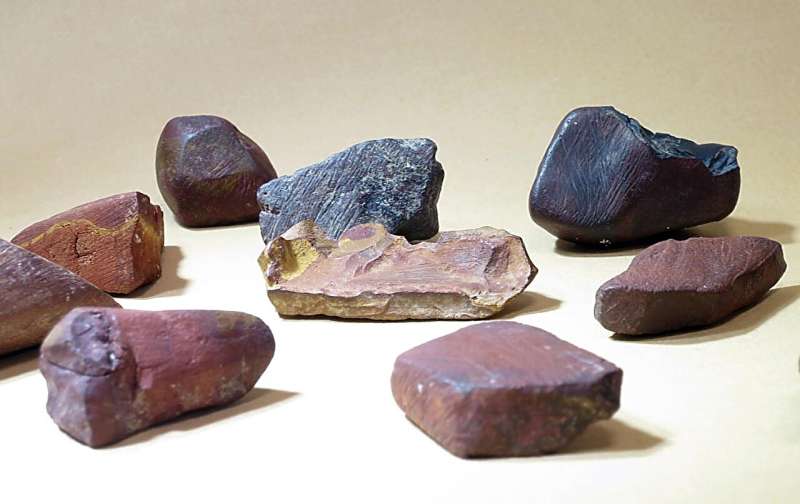This article has been reviewed according to Science X's editorial process and policies. Editors have highlighted the following attributes while ensuring the content's credibility:
fact-checked
peer-reviewed publication
proofread
Pigment production adapted to cultural changes and availability of mineral resources 40,000 years ago in Ethiopia

An international research team from Spain and France has carried out the chemical and technological analysis of the largest known collection of red and yellow mineral pigments, commonly called ochre, dated to the Middle Stone Age, between 300,000 and 40,000 years ago, and found at Porc-Epic cave, Ethiopia.
The study, published in Scientific Reports, and led by researcher Daniela Rosso (University of Valencia) in collaboration with researchers from the French CNRS, reveals that human groups visiting this site gradually modified the techniques used to produce pigments, as a result of cultural or environmental changes that limited their access to better quality raw materials.
Systematic use of pigments is considered as a key element in the cultural development of human societies. However, Paleolithic sites that yielded archaeological collections large enough to precisely trace how minerals were acquired, processed and used are rare.
The cave site of Porc-Epic, in Dire Dawa (Ethiopia), dated around 40,000 years ago, represents one of the few Paleolithic sites that have yielded a continuous and extensive record of ochre use, spanning a period of at least 4,500 years. More than 40 kg of ochre (4,213 pieces), 21 ochre processing tools, and two ochre-stained artifacts were found during the site excavation.
By analyzing the chemical composition of ochre pieces found at the site and natural ochre collected in the cave's surroundings, and studying the techniques used to process these rocks, the authors unveil that the inhabitants of the site were able to predict the properties of different ochre types accessible in their environment.
According to the article published by Daniela Rosso (University of Valencia), Martine Regert (Côte d'Azur University) and Francesco d'Errico (Bordeaux University and University of Bergen), they were able to gradually adapt their technology according to changes in the availability of raw materials.
A wide variety of ochre types were collected and brought to the site to produce ochre powder of different textures and shades, probably adapted to different symbolic or functional activities. However, the ubiquitous presence of red ochre, rich in hematite, throughout the occupations of the site, indicates that Porc-Epic inhabitants were interested in this particular color and mineral when collecting ochre pieces in their environment or exchanging them with neighboring populations.
Fine-grained ochre pieces, rich in iron oxides, rare in the surroundings of the cave, were often abraded on grindstones to produce good quality ochre powder, characterized by a fine texture and an intense red color. Lower quality ochre pieces, rich in quartz grains, abundant in the vicinity of the cave, were more often crushed to produce coarser powder.
The study reveals a change in raw material preferences throughout the site's occupations: the good quality ochre was more intensively sought at the beginning of the site occupation, while the use of lower quality ochre types gradually increased through time.
These changes in the use of ochre depict a culture in slow transition, progressively replacing exotic iron-rich high-quality rocks with lower quality, poorer in iron, but locally available ones. This could be the result of a cultural change, entailing an increasing need for coarser powder linked to a growing significance of specific activities, or to a limited access to high quality raw materials, produced by the evolution of erosive processes bringing good quality raw materials closer to the site from their primary sources.
The study of this ochre record reflects a cultural feature that was deeply rooted in the late Middle Stone Age society, but in constant evolution, during an essential period to our understanding of the emergence and evolution of complex cultures.
More information: Daniela Eugenia Rosso et al, First identification of an evolving Middle Stone Age ochre culture at Porc-Epic Cave, Ethiopia, Scientific Reports (2023). DOI: 10.1038/s41598-023-39957-y
Journal information: Scientific Reports
Provided by University of Valencia


















